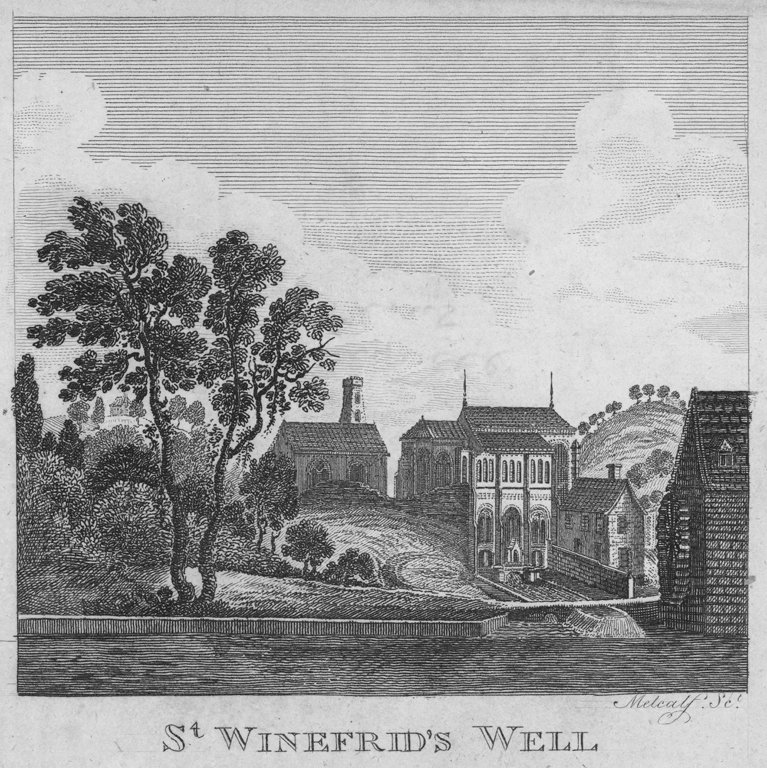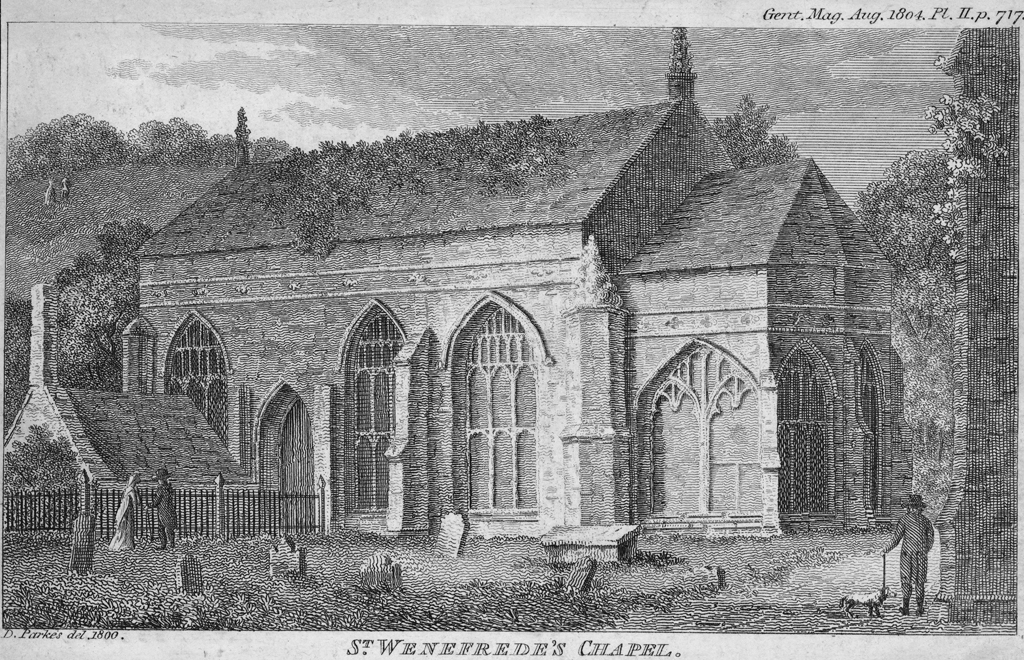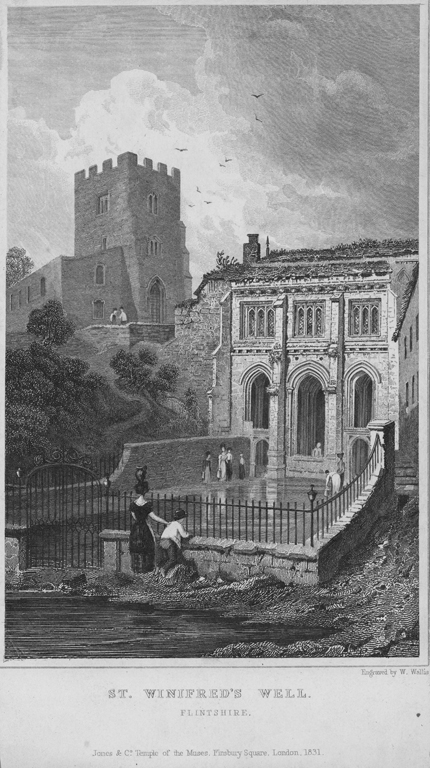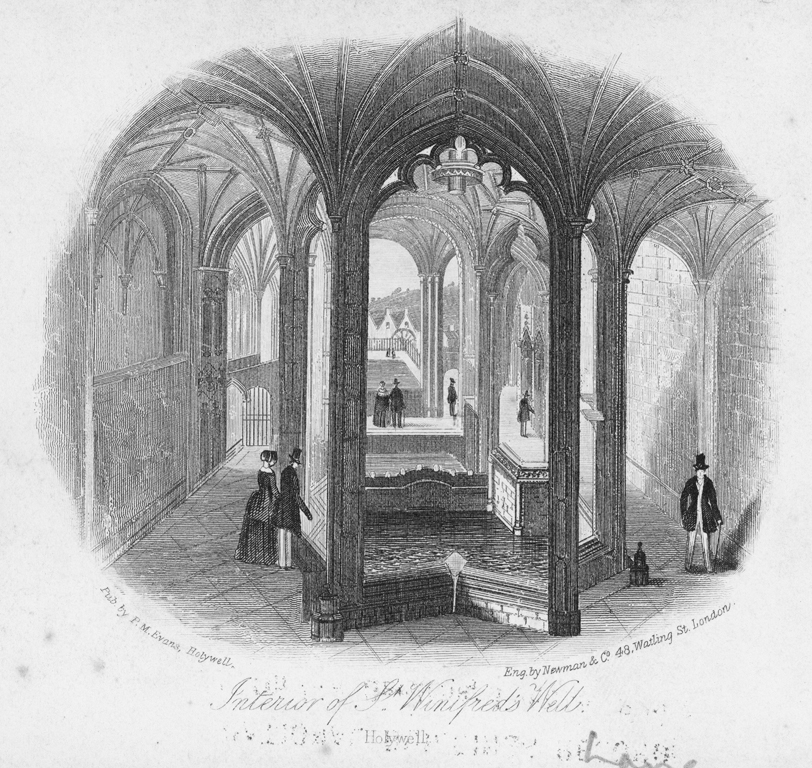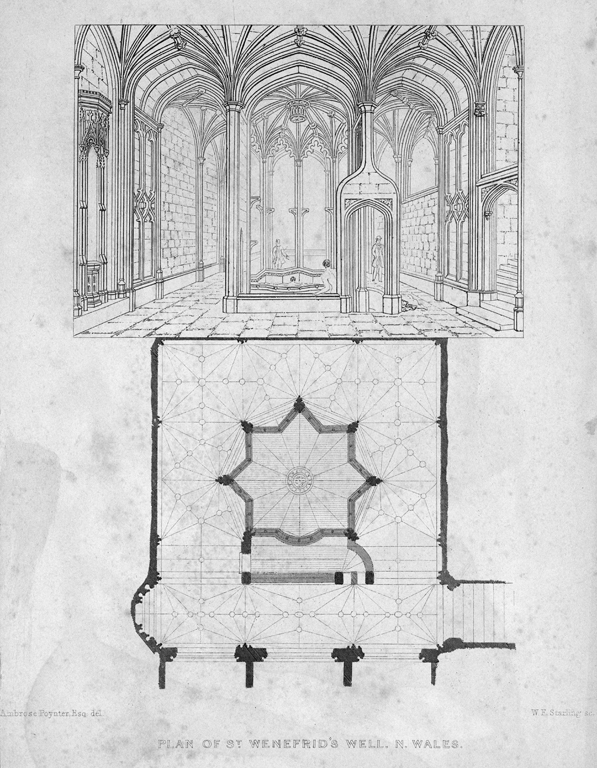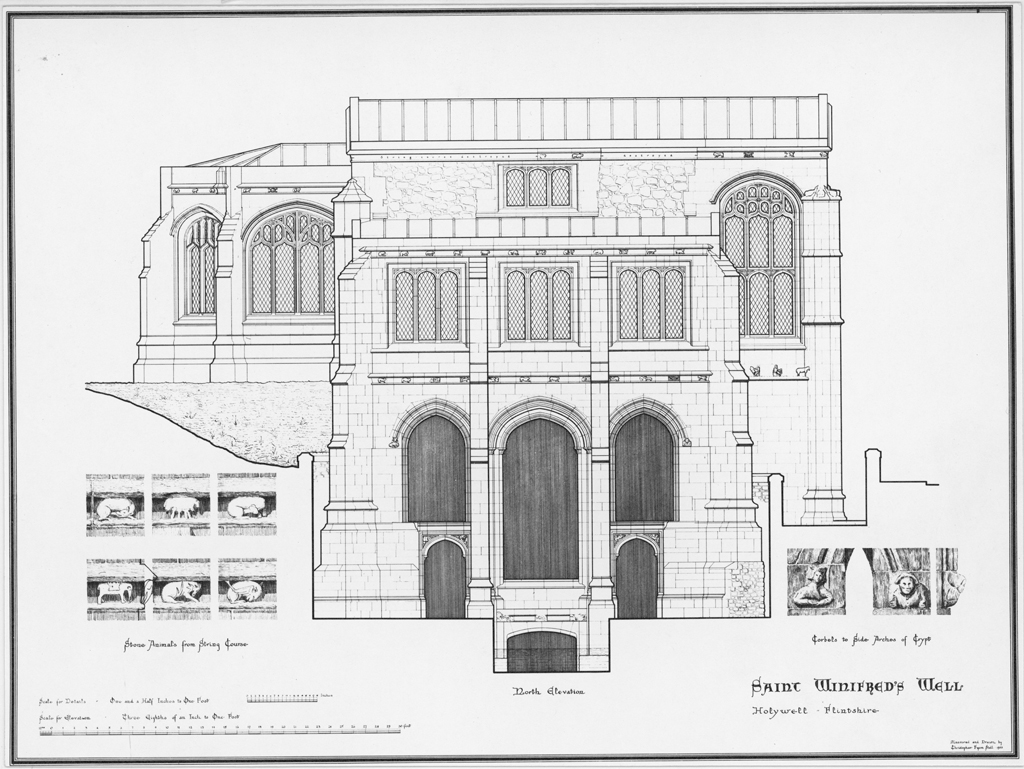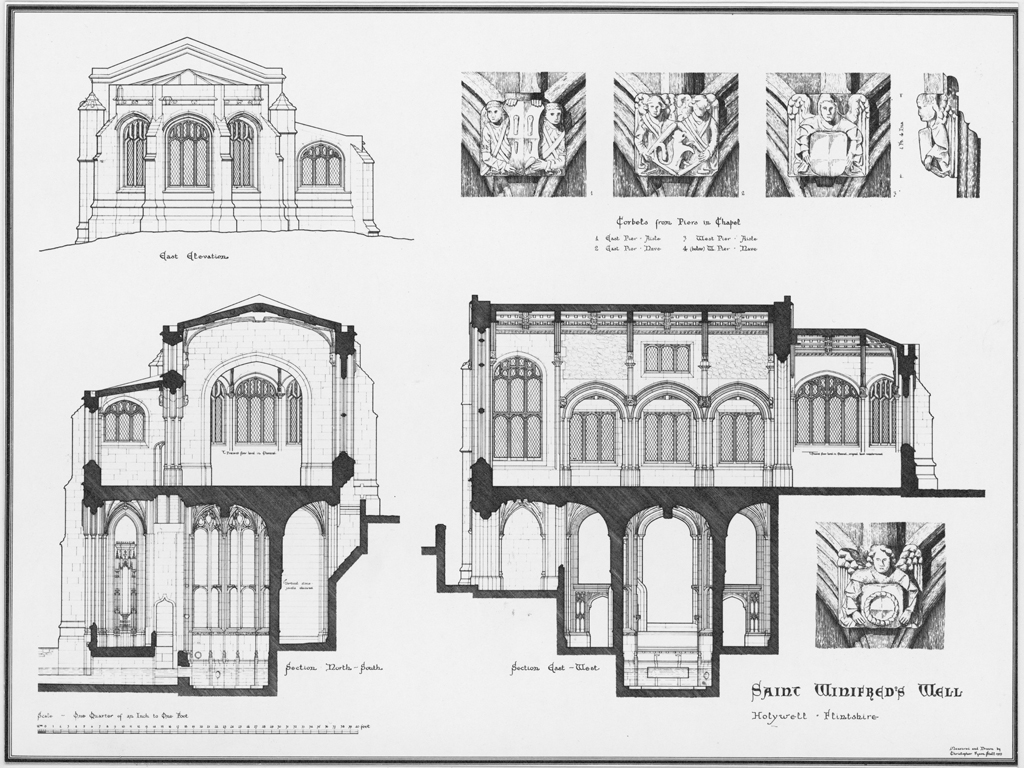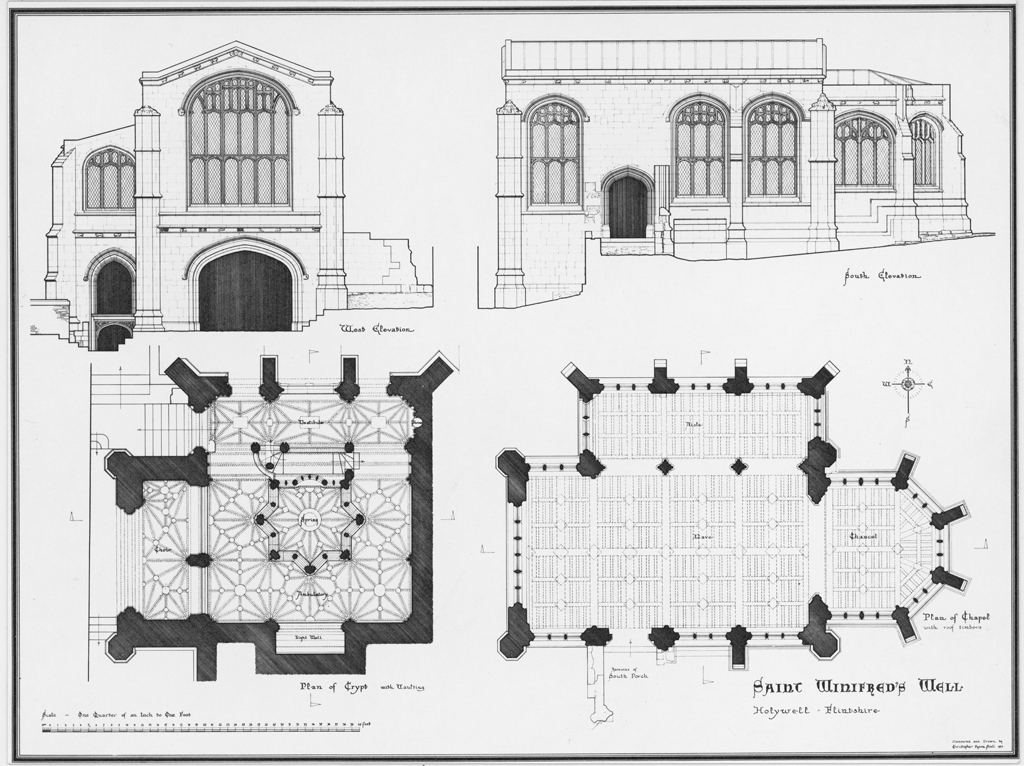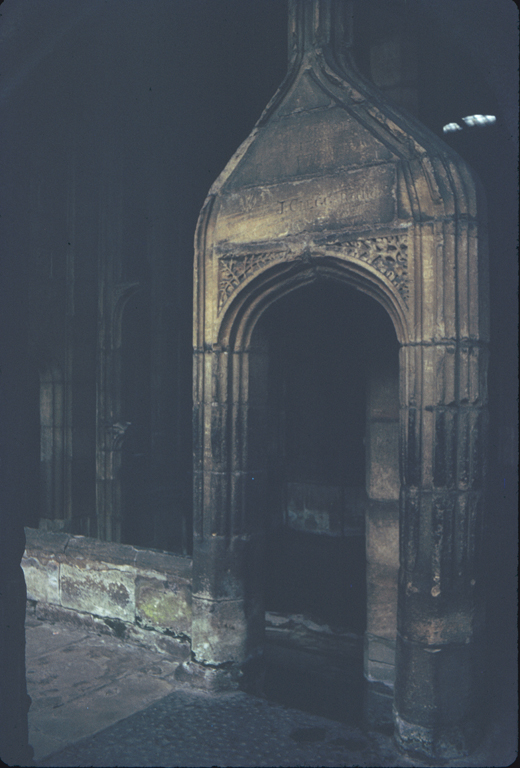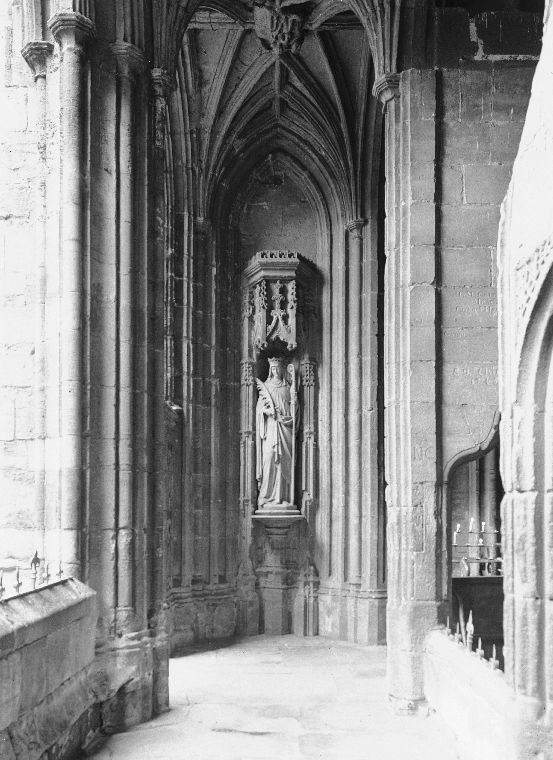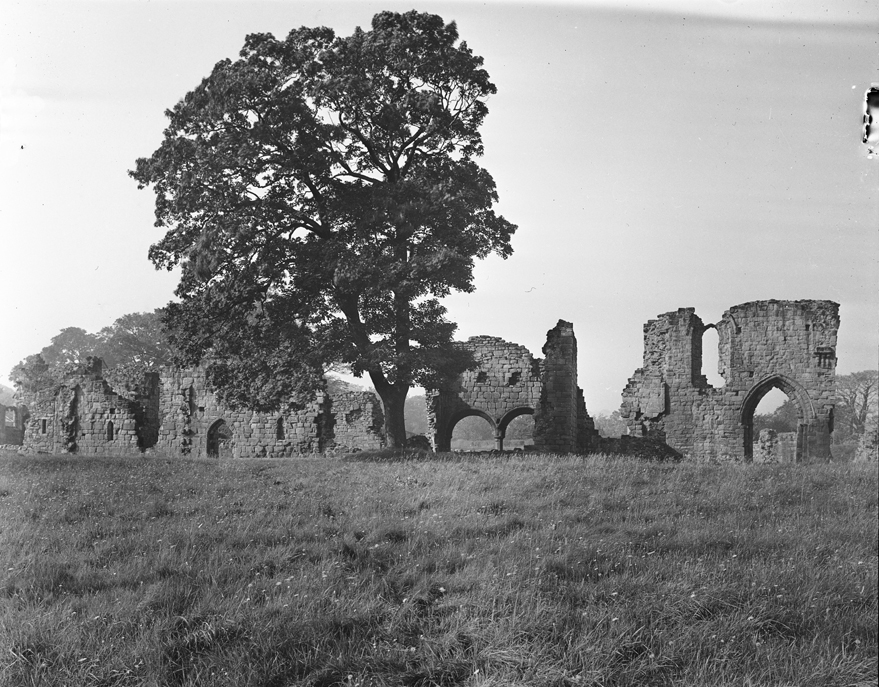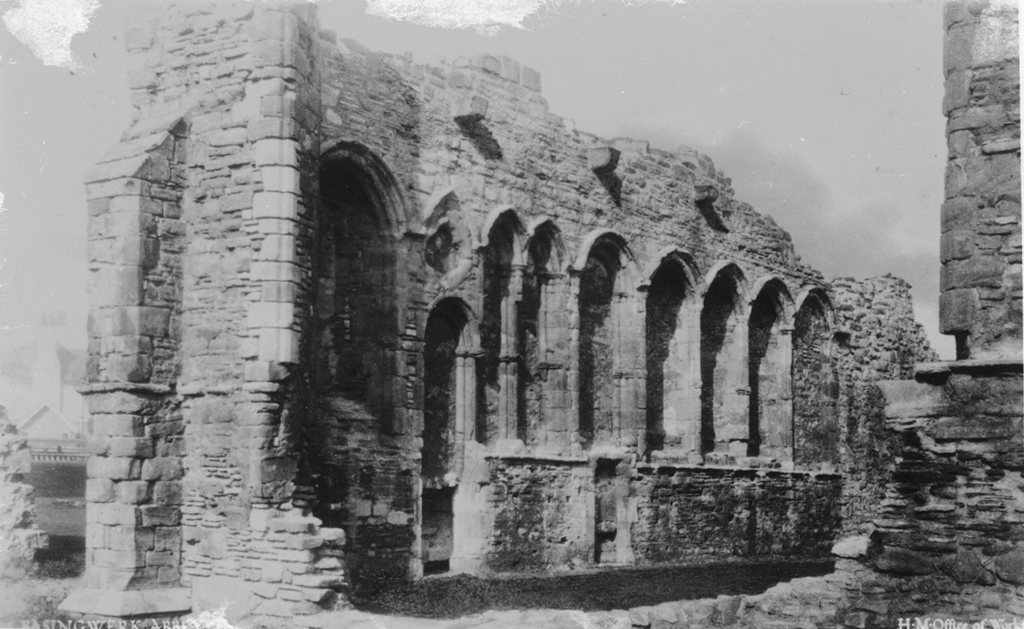St Winefride's Well - Overview
The legend of Saint Winefride, or Winifride, is of a seventh century Welsh noble woman who decided to dedicate her life to the service of the Christian church and become a nun. Enraged by her decision, her former suitor, Caradoc, confronted her and cut off her head, which rolled down a hill. Witnessing the murder of his niece, Saint Beuno rushed to the place where Winefride’s head had come to rest and brought it back to her lifeless body. Invoking judgement from heaven, Beuno succeeded in restoring Winefride’s life when he placed her head on her body, but Caradoc fell dead on the spot and was swallowed by the earth. As a sign of the miracle, a permanent faint red line traced Winefride’s throat. She stayed eight years at Holywell before retiring to another nunnery, Gwytherin, further inland. Two saint’s days are dedicated to her: the day of her miraculous resurrection and the day of her death.
The well springs from the place where the severed head was said to have come to a rest and, thanks to its reputed healing properties, it is regarded as one of the Seven Wonders of Wales. St Winefride’s Well was a place of pilgrimage as early as the twelfth century. In the fifteenth century, Margaret of Beaufort built a chapel next to the well, leading to a bathing pool for pilgrims. During the Reformation of the 1530s, Anglican reformers destroyed many Catholic shrines and relics across Great Britain, however, veneration at St Winefride’s miraculously continued through the centuries despite state suppression and persecution. In the eighteenth century, the Catholic population in the Holywell district even began to rise.
By the dawn of modern tourism in the Romantic period, travellers to the chapel and holy well regarded the site as a Catholic curiosity in an otherwise devoutly Protestant Wales. Today, St Winefride’s Well and Chapel are jointly under the care of Cadw and the Roman Catholic church and, together with the museum, are open daily.
Accounts of Travel
Reise durch England, Wales und Schottland im Jahre 1817, 1816
Samuel Heinrich Spiker (1786 – 1858)
Wir eilten bald die Hauptmerkwürdigkeit der Stadt, welcher sie auch ihren Namen (heilige Quelle, holy well) zu verdanken hat, die Quelle der heil. Winifred zu besichtigen. Die Umgebungen derselben sind so romantisch, als man sie sich nur denken kann. Die kleine gothische Pfarrkirche des Orts liegt nicht weit davon in dem von begrünten Hügeln rings umgebenen Thale; der Kirchhof mit seinen mannichfach verzierten Grabsteinen dehnt sich den Hügel hinan, und an seinem Fuße steht das Gebäude, unter welchem die Quelle entspringt. Dieses Gebäude, angeblich von der Gräfin Richmond, Mutter Heinrich VII., erbaut, ist ein schönes Denkmal der gothischen Architektur; es hat zwei Stockwerke, von denen das untere eine mit drei hohen Bogen verzierte Halle bildet, in die man eintritt und die Quelle vor sich sieht. Besondere Aufmerksamkeit verdient die reich und im besten Geschmacke verzierte Decke, ein Theil des Zimmerraums, auf dessen Anschmückung die Baumeister des Zeitalters Heinrich VIII. besondere Sorgfalt gewandt zu haben scheinen. Das obere Stockwerk, von drei Fenstern, wird zu einer Schule und zu den vierteljährlichen Gerichtssitzungen gebraucht. Das Wasser der Quelle, sehr klar, aber von einer smaragdgrünen Farbe, verbreitet sich in einem ungefähr 12 Fuß langen und halb so breiten mit Steinen ausgelegten viereckten Becken, und strömt dann unter dem mittleren Bogen weg, in das Freie hinaus, wo es sich in ein vor dem Gebäude befindliches größeres Becken sammelt, welches den Vorhof einnimmt, und sodann, noch einmal abgelassen, eine in der Nähe der Quelle stehende Mühle treiben muß. – Der Geschmack des Wassers unterscheidet sich nur unmerklich von dem des gewöhnlichen, und zwar dadurch, daß er etwas Seifenartiges hat; kaum kann man indeß sich zum Kosten desselben entschließen, indem so wohl in dem innern, als dem äußeren Becken gebadet wird, zu welchem Ende in den Ecken der Halle hölzerne mit Glasfenstern versehene Verschläge angebracht sind, in denen sich die Badenden (beiderlei Geschlechts) entkleiden. – Eine gedruckte Beschreibung der Quelle und ihrer Heilkräfte wird an derselben verkauft.
We hastened to visit the greatest curiosity of the place, the well of Saint Winifred; to which the town is indebted for its name of Holywell. The surrounding country is of the most romantic description. The little Gothic church is situated at a small distance from the town, in a vale surrounded by verdant hills; the church-yard, with its numerous tomb-stones, variously decorated, stretches up the side of the hill; at the foot of this hill stands the building under which the spring rises. This building, said to have been erected by the Countess of Richmond, mother to Henry VII., is a beautiful monument of Gothic architecture. It has two stories, of which the lower forms a hall, adorned by three lofty arches, and on entering it we perceive the spring. The roof of this hall, richly ornamented in the best taste, is deserving of particular attention. This is a part of the building to the ornamenting of which the architects of the age of Henry VIII.’s reign appear to have paid singular attention. The upper story, which has three windows, is used as a school, and for the quarter sessions. The water of this spring is very clear, but of an emerald green colour, flowing into a basin of twelve feet in length, and half of that dimension in breadth, lined with square stones, then flowing under the central arch into the open air, where it is collected in a larger basin in front of the building, which fills the fore court; and then leaving this basin it drives a mill in the vicinity of the spring. The taste can hardly be distinguished from that of common water. The difference consists merely in its being somewhat alcaline. However, it is not easy to bring one’s mind to taste it, for both the internal and external basins are used for bathing; for which purpose there are wooden recesses with stained glass windows in the corners of the hall, where the bathers (of both sexes), undress themselves. A printed description of the well and its virtues is sold on the spot.
(Travels through England, Wales and Scotland in the Year 1816. Vol 2. London: 1820)
Historisch-statistische Darstellung des nördlichen Englands nebst vergleichenden Bemerkungen auf einer Reise durch die südwestlichen Grafschaften, 1823
Eduard Florens Rivinus (1802 – 1873)
Holywell ist nicht ganz eine Stunde Wegs von der Küste entfernt und liegt zusammengedrängt in einem tiefen, von hohen Bergen rings umgebenen Kessel. Durch die See von dem wogenden Gewühle Liverpools und desen industriöser Umgebung geschieden, würde, da die Annehmlichkeiten einer schönen Natur ihm nur spärlich zugemessen sind, selten ein Wanderer es besuchen, wenn nicht ein anderer Zauber ihm zugetheilt wäre, der sowohl Hülfsbedürftige als Schaulustige hieher zöge und die düstere Einsamkeit des Ortes dadurch in vieler Hinsicht milderte. Es ist dieß ein merkwürdiger Quell, berühmt erstlich durch seine Entstehung unter dem Namen St. Winfried’s Quell, und berühmt, anderns, wie die Bewohner des Ortes und der Umgegend, angeblich nach dem unumstößlichen Zeugniß mehrer Aerzte, behaupten, durch seine Heilkräfte. Die Geschichte seines Ursprungs aber hat einen doppelten Werth: sie ist nämlich so unbegreiflich, daß sie den Skeptiker belustigt, und zweitens so wunderbar, daß sie den Gläubigen über die Maaßen erquickt. In Ermangelung anderer der Aufzeichnung werther Gegenstände, sei es mir darum vergönnt, den Leser mit der Erzählung derselben zu unterhalten, wobei ich jedoch weit entfernt bin dessen Urtheil vorzugreifen, sondern ihm bereitwillig die Wahl lasse, ob er es mit der Partei der Skeptiker oder mit der der Gläubigen zu halten gemeint sei.
Es lebte im siebenten Jahrhundert in dieser Gegend ein Mägdlein Namens Winfried, die im Rufe ungewöhnlicher Heiligkeit stand; denn sie hatte das Gelübde ewiger Keuschheit abgelegt. Sie hatte sich dem Dienste des Himmels geweihet und unter den Schutz und die Fürsorge ihres Oheims Benno gestellt, der nach der damaligen Gewohnheit der Reichen und Frommen ein Kirchlein allda errichtet hatte, worin er den Gottesdienst selbst verrichtete. Zur selbigen Zeit aber lebte in der Nachbarschaft ein heidnischer Prinz, der Cradoc hieß, und von des frommen Mädchens Schönheit dergestalt entzückt ward, daß er entschlossen war, um jeden Preis ihren Besitz sich zu erwerben. Er trug der Gottgeweiheten seine Liebe an, die alsbald sich davor entsetzte und die Flucht ergriff. Der Heide gerieth in Wuth ob der unerwarteten Täuschung seiner Hoffnungen und verfolgte sie augenblicklich, und wie er sie erreichte, zog er den Säbel und hieb ihr das Haupt ab. Der verdiente Lohn aber folgte schnell der blutigen That. Todt fiel er zu Boden und die Erde that sich auf und verschlang den Leib des Gottlosen. Und des Mägdleins Haupt rollte einen Berg hinab und ruhete in der Nähe des Kirchleins. Da trat der heilige Benno hinzu, hob es auf und begab sich damit zu dem Leichnam. Und wie er seine Gebete verrichtet und fromme Gelübde gethan hatte, da setzte er ihm den Kopf auf und siehe da, er wuchs wieder mit ihm zusammen. Nachdem sich aber solches begeben, lebte sie noch fünfzehn Jahre dem Dienste des Herrn und der Befolgung ihres Gelübdes.
... Der Tag ihrer Enthauptung war der 22. Juni, welcher darum noch heut zu Tage festlich begangen wird. So weit die Erzählung dieses Wunders.
Nach dem Tode der Jungfrau erwies sich ihre Heiligkeit durch vielerlei Wunder. Das Wasser des Quelles wird von den Aerzten für so heilsam gehalten, daß kein Anderes im ganzen Universum diesem gleich zu achten sei, daher Leute aus allen Ständen in ungeheurer Anzahl glaubensvoll dahin wallfahrten. Es heilt alle Schwächen des menschlichen Körpers, fobald man darin badet, und zum Zeichen seiner Kräfte sind die Krücken der Genesenen und andere Unterstützungsmittel gelähmter oder kranker Glieder als Trophäen gleichsam an der Decke des über den Quell erbaueten Daches aufgehangen worden. Die Quelle friert niemals zu und erleidet nie einen Wechsel, weder zur Zeit der Dürre, noch nach dem heftigsten Regen. Sie quillt mit reißender Hast aus einem Felsen, worauf ihre Wasser in einem großen runden Steinbassin sich sammeln. Darüber ist ein von steinernen Pfeilern getragenes Dach erbauet, an welchem unmittelbar über der Quelle die Legende von der heiligen Winfried zu lesen ist. Einem in Gemäßheit einer darüber gemachten Wette angestellten Versuche zufolge, wobei das Basin, das ungefähr 240 Tonnen Wasser faßt, ausgeleert und in weniger als zwei Minuten wieder angefüllt wurde, producirt dieser mächtige Quell in einer einzigen Minute mehr als hundert Tonnen Wasser.
Wie dem nun auch sein mag, so scheinen doch die Heilkräfte dieses Quelles bedeutend abgenommen zu haben, da sogar, wie in der letzten Hälfte dieses Jahres in öffentlichen Blättern angezeigt wurde, der ferne sonst so kräftige Beistand des wunderthätigen Prinzen von Hohenlohe respective an Beten und Singen, zu dem mehre hülfsbedürftige Gläubige dieses Ortes ihre Zuflucht genommen hatten, folglich in der Nähe des heiligen Wassers selbst, ohne Einfluß und Wirkung geblieben war.
Holywell is situated just under an hour from the coast and lies huddled in a deep recess surrounded by lofty hills. Divided by the sea from the churning hubbub of Liverpool and its industrious surroundings, and the pleasantries of beautiful nature having been apportioned to it only sparsely, a pedestrian traveller would rarely stray to this spot, had it not been graced with another enchantment which attracts those seeking relief and curious onlookers alike and so softens the gloomy solitude of this place in many ways. It is a curious well, famed, firstly, based on its origin, as St Winefride’s Well, and secondly, it is regarded for its healing powers as they are proclaimed by the people of the town and its surroundings, apparently following the indisputable testimonials of numerous doctors. The history of its origin is doubly valuable: for it is so incredible that it amuses the sceptic as well as being so fantastical that it revitalises the devout to excess. In the absence of other subjects worthy of notice, I beg leave to entertain the reader with the account of its origin without attempting to presume his verdict, but readily leave the decision to him whether to join the party of the sceptics or that of the pious.
In the seventh century, a maid by the name of Winefride lived in this part. She was reputed for her uncommon holiness for she had taken the solemn vow of eternal maidenhood. She had consecrated herself to Heavenly service and had placed herself under the protection and welfare of her uncle Beuno, who, according to the old custom of the rich and devout, had established a small church in this spot where he administered the divine service himself. But it was at the same time that a heathen prince named Cradoc lived nearby; he had been enchanted by the maiden’s beauty in such a way that he decided to take possession of her at any cost. He offered his love to the consecrated maiden who recoiled in horror and took flight. Upon finding his hopes dashed unexpectedly, the enraged heathen pursued her momentarily, and upon reaching her, he pulled his sword and struck off her head. However, the deserved reward followed this bloody deed swiftly. He fell dead on the spot and the godless heathen’s body was swallowed up by the ground. But the maiden’s head rolled down the hill and came to rest near the little church. At once, the holy Beuno stepped near, picked up the head and repaired to the body. And as he had completed his prayers and declared his godly vows, he placed the head on the body and, lo!, they re-joined again. After these events, she lived another fifteen years in the service of the Lord and in dedication to her vow.
... The day of her beheading was 22 June, which is therefore still observed today with a feast. Such is the tale of this miracle.
After the maiden’s death, her holiness manifested itself in various miracles. Doctors attribute such healing powers to the water of the well that no other in the universe is considered its equal and therefore, people of all orders make pilgrimage to this site in prodigious numbers. It heals all weaknesses of the human body as soon as one bathes therein. And as a sign of its potency, the crutches of the convalescents and other supports for lame and deceased limbs hang as trophies from the ceiling of a roof that has been erected above the well. It never freezes shut and never suffers alteration, neither during times of drought nor following heavy rains. It rises in burbling haste from a rock whereupon its waters gather in a large round stone basin. Above, a roof has been installed which is carried by stone pillars and on which one can read the legend of St Winefride directly above the well. Following a wager, an experiment was carried out accordingly in which the basin, containing an estimated 240 tons of water, was emptied and it refilled itself in under two minutes, proving that this mighty well produces in only one minute more than one hundred tons of water.
Be that as it may, the healing powers of this well appear to have weakened considerably. As it was reported in the public papers during the second half of this year, even the distant otherwise so powerful support of the miracle-working Prince of Hohenlohe with regards to prayer and song, with whom numerous help-seeking believers of this place had sought shelter, in proximity thus to the holy water itself, remained bereft of influence or effect.
Voyage de Paris à Dublin à travers la Normandie et l’Angleterre en 1789, 1789
Charles-Etienne Coquebert de Montbret (1755 – 1831)
Holywell à deux milles de la mer est situé vers le milieu de la pente d’une montagne fort élevée (En gallois: Treffynnon, la ville de la fontaine). Sa première origine est due à la source qui prend naissance dans une enceinte voûtée octogonale sous une chapelle et qui est si abondante qu’elle fait tourner aussitôt plusieurs moulins (Pennant dit qu’elle fournit 21 tonnes d’eau par minute). C’est un volume d’eau considérable et qui a une très grande pente. On en a profité pour y établir 3 filatures de coton qui travaillent pour Manchester et pour l’Ecosse. Nous ne pûmes les voir. On n’y fait travailler que des femmes et des filles, les hommes en sont exclus. ... un moulin à papier, un à tabac. Il y a aussi sur cette rivière trois martinets à cuivre et un où l’on fabrique du cuivre jaune par le mélange de la calamine à l’instar d’Aix-la-Chapelle. Les fonderies de plomb sont à deux miles. On nous nomme l’endroit Greenfield (A Basingwerth se termine un ancien fossé nommé le Wat Maes glas en gallois, c’est l’ancien abe de Basingwerth). Il n’est pas étonnant que les habitants aient vénéré cette fontaine dont la naissance est si singulière; mais elle est digne de leurs hommages à présent qu’elle y fait subsister tant de personnes industrieuses. (Ste Winifrede fut décapitée en haut de la Montagne par Caradoc, fils du roi Alen, son amant; sa tête s’arrêta là. Saint-Beuno la recolla et la sainte vécut encore 15 ans après. Son corps fut porté à Shrewsbury. La source est aussi fréquentée des protestants que des catholiques. Son eau d’ailleurs est sans goût et très pure et si elle a fait du bien aux personnes qui s’y baignent c’est sans doute comme toute autre eau bien froide (Au reste, le nombre des pélerins diminue chaque année). On distribue à la chapelle un imprimé qui raconte son origine miraculeuse en ajoutant que l’Ancien et le Nouveau Testament offrent des choses tout aussi surprenantes et que par conséquent, on ne doit pas plus douter de celle-ci.
Holywell, two miles from the sea, is situated near the middle of the slope of a high mountain (In Welsh: Treffnynnon, town of the well). It owes its first origin to the spring that rises in an octagonal, vaulted enclosure beneath a chapel, a spring in such plentiful supply that it runs several water mills right there (Pennant says that it provides 21 tonnes of water per minute). That is a considerable volume of water and on a very steep slope. It has been used to good effect to establish 3 cotton mills that work for Manchester and Scotland. We were unable to see them. Only women and girls are put to work there, men are excluded. ... One paper mill, one tobacco. There are also three copper tilt hammers along this river, and one where yellow copper is made by mixing in calamine after the fashion of Aix-la-Chapelle [i.e. Aachen]. The lead foundries are two miles away. We are told the area is called Greenfield (At Basingwerth an ancient channel called the Wat Maes glas in Welsh ends, this is the ancient Basingwerth Abbey). It is no surprise that the inhabitants should have venerated this spring whose birth is so remarkable; but it deserves their tributes now because it gives work to so many industrious people. (Saint Winifred was decapitated on the mountaintop by her lover Caradog, son of King Alen; her head stayed there. Saint Beuno stuck it back on and the Saint lived another 15 years afterwards. Then her body was taken to Shrewsbury. The spring is just as visited by Protestants as by Catholics. Its water, in fact, is without taste and very pure, and if it has benefitted the people who bathe in it, this is probably just like any other nicely cold water (What is more, the number of pilgrims gets smaller each year). A leaflet is distributed in the chapel which recounts the miraculous story, noting that both the Old Testament and the New Testament record things which are no less surprising, and that therefore we should have no more doubt about the story of the well.
"Voyage au nord du pays de Galles", c. 1866
Arthur d’Arcis ( – )
Après Flint, Holywell. La gare est à 3 kilomètres de la ville et fait partie du pauvre village de Greenfield. Si l’on tourne le dos à la Dee on remarque à gauche une éminence couronnée de ruines. C’est là tout ce qui reste de l’abbaye de Basingwerk fondée au XIIme siècle. Dans un beau pré et à l’ombre d’arbres superbes se dressent quelques pans de murs percés de fenêtres à ogive et une grande porte isolée qui fait l’effet d’un arc de triomphe. Les matériaux consistent en pierres cubiques rouges, brunies par le temps. En s’avançant au bord de l’éminence on découvre les traces d’un fossé et l’on jouit d’une vue très étendue sur la Dee et la côte du Cheshire. ... Mais voici Holywell ou Treffynon, la ville du puits, petite ville de 5000 habitants possédant des filatures de laine, des fonderies et une délicieuse petite chapelle qui est la merveille de la contrée. En voici l’origine et la légende:
Au commencement du VIIme siècle, Gwenfrewi ou Winefred, parente de saint Bueno, l’un des patrons du pays de Galles, demeurait à Holywell et était recherchée par un chef gallois, nommé Caradoc. Aux instances passionnées de ce barbare, elle opposait le silence ou le mépris, allumant ainsi la fureur de celui qui la désirait. Un jour enfin Caradoc rencontra Winefred sur la colline qui ferme comme un rempart la vallée de Holywell. Une fois encore il l’implora, il la supplia de l’écouter favorablement, et en ayant été repoussé comme auparavant, il ne put se maîtriser plus longtemps et d’un seul coup d’épée lui trancha la tête. Celle-ci roula au pied de la colline et ne s’arrêta que sur un petit plateau. A cet endroit même jaillit une source d’eau fraîche et pure qui fut plus tard rassemblée dans un puits, et sur le puits fut élevée en guist de baldaquin une charmante chapelle gothique de pierre, aux colonnes élancées, aux nervures déliées, aux ornements délicatement scupltés. Quelques rares ex-voto, béquilles ou cannes, sont accrochés aux colonnes et aux murs. Deux escaliers descendent à la piscine entourée d’un promenoir sur lequel s’ouvrent des cabines très simples. Tout cet ensemble est connu sous le nom de puits de Ste Winifred et appartient aux catholiques qui prélèvent un petit droid d’en trées sur ceux aui le visitent ou qui en usent. Holywell lui-même, du reste, est un centre catholique et possède deux écoles, l’une dirigées par les jésuites et l’autre par les sœurs. Dans les environs il y a aussi un couvent de moines. J’ai été agréablement surpris en apprenant qui moines, sœurs et jésuites étaient fort bien vus par la populatino galloise aui, comme on le sait, est ultra-protestante. Voilà un bel exemple de tolérance, qui honore à la fois les habitants du pays et les membres du clergé que l’Église de Rome envoie dans ces parages.
After Flint, Holywell. The station is 3 Kilometres from the town and is part of the poor village of Greenfield. If you turn your back to the Dee you notice on the left a hill crowned by ruins. That is all that remains of the Basingwerk Abbey, founded in the twelfth century. In a fine meadow and in the shade of superb trees, stand some fragments of wall, containing Gothic windows and a large isolated door that gives the impression of being an triumphal arch. The materials are red cube-shaped stones, made brown by the weather. Towards the edge of the hill you see the traces of a dyke and enjoy a panoramic view of the Dee and the Cheshire coast. ... But here is Holywell or Treffynon, town of the well, a little town of 5,000 inhabitants that possesses woollen mills, foundries and a delightful little chapel that is the marvel of the whole area. This is its origin and legend:
At the beginning of the seventh century, Gwenffrewi or Winifred, a relation of Saint Beuno, one of the patron saints of Wales, lived at Holywell and was desired by a Welsh chief named Caradog. The silence or scorn with which she met this Barbarian’s passionate insistence only ignited his fury. One day Caradog finally met Winifred on the hill that is like a rampart around the valley of Holywell. He begged her one more time, pleaded with her to listen to him favourably, and on being rejected like before, could not control himself any longer and with one swipe cut off her head. The head rolled to the bottom of the hill without stopping until it reached a little plateau. At this very spot rose a spring of pure, cold water that was later collected in a well, and above the well was built, as a canopy, a charming little Gothic chapel in stone, with slender columns, with delicate ribs, with delicately sculpted ornaments. The odd commemorative plaque, crutch or walking stick, is hangs on the columns and walls. Two staircases lead down to the pool, which is surrounded by a pavement onto which some very simple cabins open out. All this is together known by the name of Saint Winifred’s well and belongs to the Catholics who charge a small entry fee for those who wish to visit or use it. Holywell itself, by the way, is a Catholic centre and has two schools: one run by Jesuits and the other by nuns. In the area there is also a monastery. I was pleasantly surprised to learn that the monks, nuns and Jesuits were well respected by the Welsh population who, as is well known, are ultra-Protestant. Here is a good example of tolerance that is a credit to both the inhabitants of the country and the members of the clergy that the Roman Church sends to these parts.
